Citroen C ZERO 2017 1.G Repair Manual
Manufacturer: CITROEN, Model Year: 2017, Model line: C ZERO, Model: Citroen C ZERO 2017 1.GPages: 174, PDF Size: 4.57 MB
Page 61 of 174
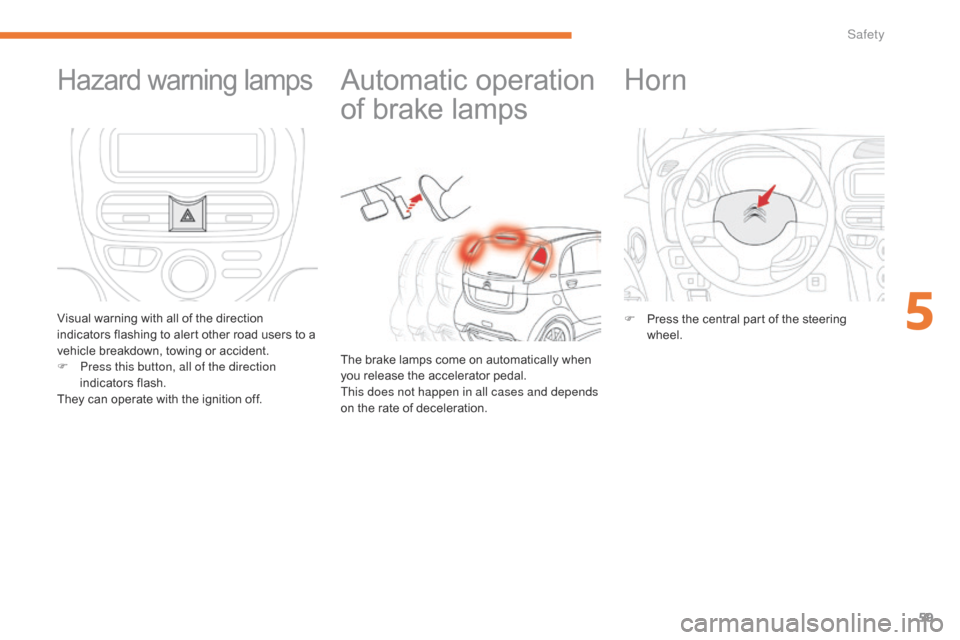
59
C-Zero_en_Chap05_securite_ed01-2016
Automatic operation
of brake lamps
The brake lamps come on automatically when
you release the accelerator pedal.
This does not happen in all cases and depends
on the rate of deceleration.
Hazard warning lamps
Visual warning with all of the direction
indicators flashing to alert other road users to a
vehicle breakdown, towing or accident.
F
P
ress this button, all of the direction
indicators flash.
They can operate with the ignition off.
Horn
F Press the central part of the steering wheel.
5
Safety
Page 62 of 174

60
C-Zero_en_Chap05_securite_ed01-2016
Pedestrian horn*
System used to warn pedestrians of the presence of the vehicle.
When the vehicle is started, lighting of the
indicator lamp on the button for a few seconds
indicates the activation of the system.
The warning is heard when the vehicle speed is
between 0 and 22 mph (0 and 35 km/h).
Deactivation
In certain driving conditions, you can deactivate
the system.Press this button.
The indicator lamp on the button comes on and
the audible warning stops.
Pressing the button again reactivates the
system.
The indicator lamp on the button switches off. Before deactivating the system, ensure
that you are not driving in an area
frequented by pedestrians.
Operation
* Depending on equipment.
Operating fault
If a system fault occurs, the indicator lamp on
the button flashes. Contact a CITROËN dealer
or a qualified workshop to have the system
checked.
The system is reactivated automatically
each time the vehicle is started.
Safety
Page 63 of 174
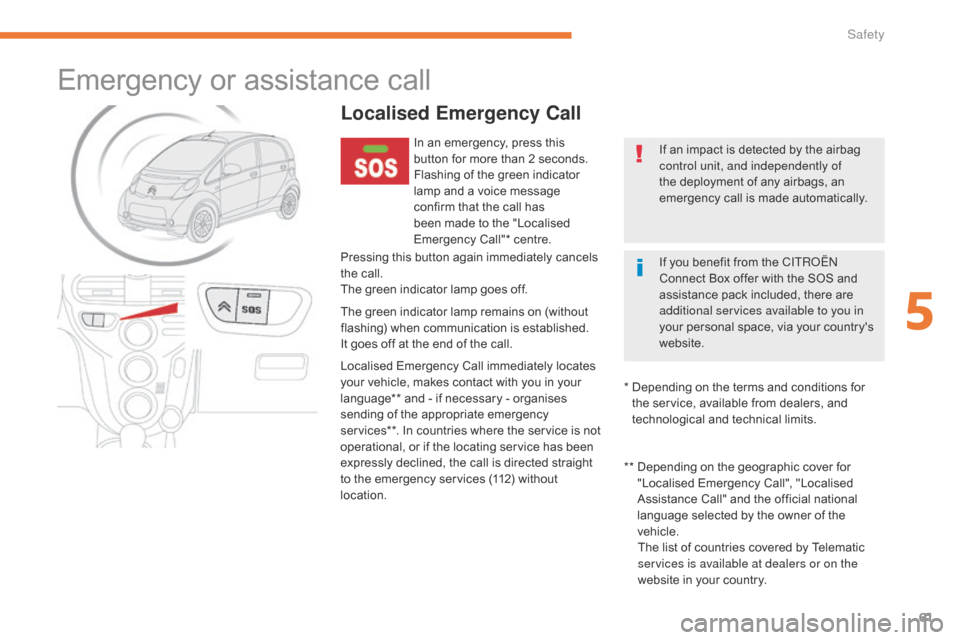
61
C-Zero_en_Chap05_securite_ed01-2016
Emergency or assistance call
Localised Emergency Call
In an emergency, press this
button for more than 2 seconds.
Flashing of the green indicator
lamp and a voice message
confirm that the call has
been made to the "Localised
Emergency Call"* centre.
Pressing this button again immediately cancels
the call.
The green indicator lamp goes off.
The green indicator lamp remains on (without
flashing) when communication is established.
It goes off at the end of the call.
Localised Emergency Call immediately locates
your vehicle, makes contact with you in your
language**
and - if necessary - organises
sending of the appropriate emergency
services**. In countries where the service is not
operational, or if the locating service has been
expressly declined, the call is directed straight
to the emergency services (112) without
location. If an impact is detected by the airbag
control unit, and independently of
the deployment of any airbags, an
emergency call is made automatically.
*
D
epending on the terms and conditions for
the service, available from dealers, and
technological and technical limits.
**
D
epending on the geographic cover for
"Localised Emergency Call", "Localised
Assistance Call" and the official national
language selected by the owner of the
vehicle. The list of countries covered by Telematic
services is available at dealers or on the
website in your country. If you benefit from the C
ITROËN
C
onnect Box offer with the SOS and
assistance pack included, there are
additional services available to you in
your personal space, via your country's
website.
5
Safety
Page 64 of 174
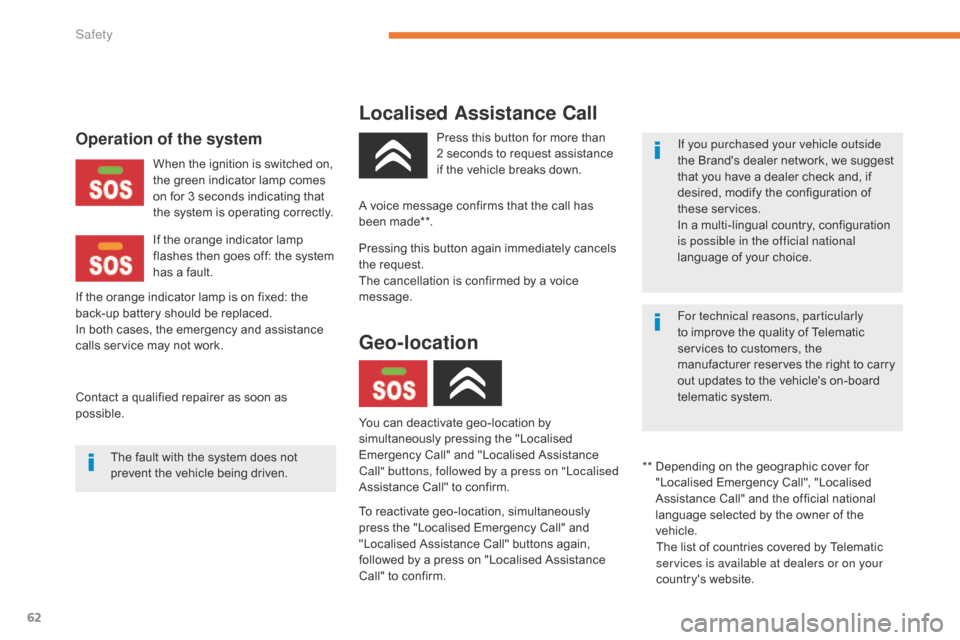
62
C-Zero_en_Chap05_securite_ed01-2016
Localised Assistance Call
To reactivate geo-location, simultaneously
press the "Localised Emergency Call" and
"Localised Assistance Call" buttons again,
followed by a press on "Localised Assistance
Call" to confirm.
Operation of the systemPress this button for more than
2 seconds to request assistance
if the vehicle breaks down. If you purchased your vehicle outside
the Brand's dealer network, we suggest
that you have a dealer check and, if
desired, modify the configuration of
these services.
In a multi-lingual country, configuration
is possible in the official national
language of your choice.
For technical reasons, particularly
to improve the quality of Telematic
services to customers, the
manufacturer reserves the right to carry
out updates to the vehicle's on-board
telematic system.
The fault with the system does not
prevent the vehicle being driven. When the ignition is switched on,
the green indicator lamp comes
on for 3 seconds indicating that
the system is operating correctly.
If the orange indicator lamp
flashes then goes off: the system
has a fault.
If the orange indicator lamp is on fixed: the
back-up battery should be replaced.
In both cases, the emergency and assistance
calls service may not work.
Contact a qualified repairer as soon as
possible. A voice message confirms that the call has
been made**.
**
D
epending on the geographic cover for
"Localised Emergency Call", "Localised
Assistance Call" and the official national
language selected by the owner of the
vehicle. The list of countries covered by Telematic
services is available at dealers or on your
country's website.
Pressing this button again immediately cancels
the request.
The cancellation is confirmed by a voice
message.
Geo-location
You can deactivate geo-location by
simultaneously pressing the "Localised
Emergency Call" and "Localised Assistance
Call" buttons, followed by a press on "Localised
Assistance Call" to confirm.
Safety
Page 65 of 174
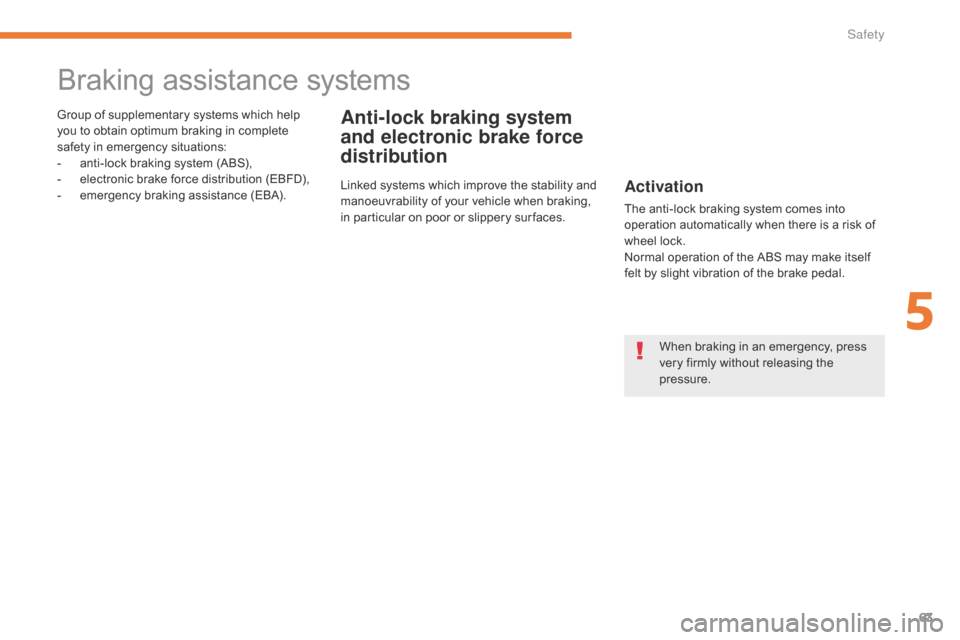
63
C-Zero_en_Chap05_securite_ed01-2016
Braking assistance systems
Anti-lock braking system
and electronic brake force
distributionGroup of supplementary systems which help
you to obtain optimum braking in complete
safety in emergency situations:
-
a
nti-lock braking system (ABS),
-
e
lectronic brake force distribution (EBFD),
-
e
mergency braking assistance (EBA).
When braking in an emergency, press
very firmly without releasing the
pressure.
Activation
The anti-lock braking system comes into
operation automatically when there is a risk of
wheel lock.
Normal operation of the ABS may make itself
felt by slight vibration of the brake pedal.
Linked systems which improve the stability and
manoeuvrability of your vehicle when braking,
in particular on poor or slippery sur faces.
5
Safety
Page 66 of 174
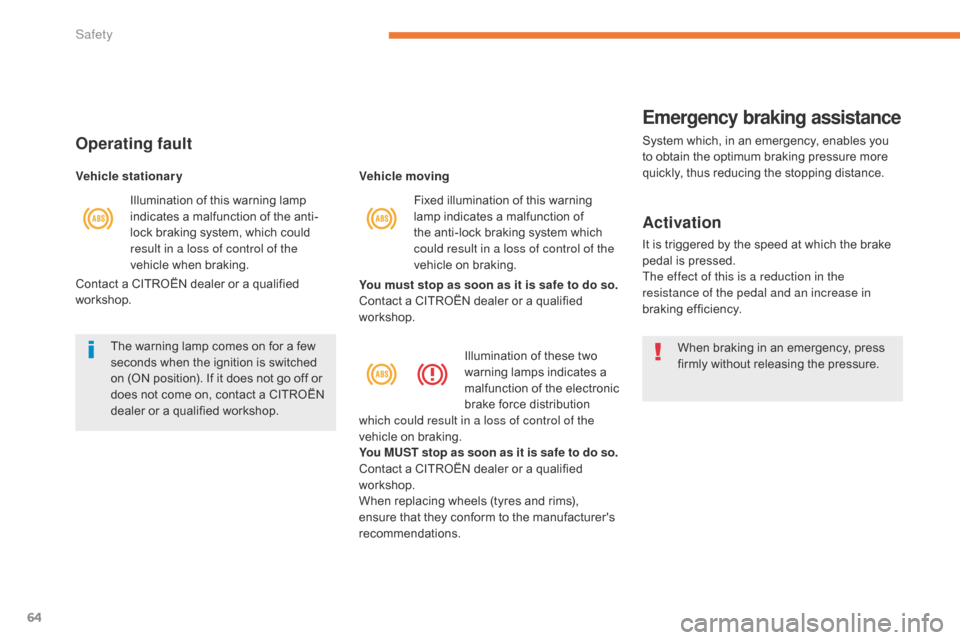
64
C-Zero_en_Chap05_securite_ed01-2016
You must stop as soon as it is safe to do so.
Contact a CITROËN dealer or a qualified
workshop. Vehicle movingIllumination of these two
warning lamps indicates a
malfunction of the electronic
brake force distribution
which could result in a loss of control of the
vehicle on braking.
You MUST stop as soon as it is safe to do so.
Contact a CITROËN dealer or a qualified
workshop.
When replacing wheels (tyres and rims),
ensure that they conform to the manufacturer's
recommendations.
Emergency braking assistance
System which, in an emergency, enables you
to obtain the optimum braking pressure more
quickly, thus reducing the stopping distance.
Activation
It is triggered by the speed at which the brake
pedal is pressed.
The effect of this is a reduction in the
resistance of the pedal and an increase in
braking efficiency.
When braking in an emergency, press
firmly without releasing the pressure.
Operating fault
Vehicle stationary
The warning lamp comes on for a few
seconds when the ignition is switched
on (ON position). If it does not go off or
does not come on, contact a CITROËN
dealer or a qualified workshop.Illumination of this warning lamp
indicates a malfunction of the anti-
lock braking system, which could
result in a loss of control of the
vehicle when braking.
Contact a CITROËN dealer or a qualified
workshop. Fixed illumination of this warning
lamp indicates a malfunction of
the anti-lock braking system which
could result in a loss of control of the
vehicle on braking.
Safety
Page 67 of 174

65
C-Zero_en_Chap05_securite_ed01-2016
Anti-slip regulation (ASR)
and electronic stability
programme (ESP)
Trajectory control systems
Deactivation
In exceptional conditions (starting a vehicle
which is bogged down, stuck in snow, on soft
ground, etc.), it may be advisable to deactivate
the ASR and ESP systems to regain grip.
F
P
ress this button button, located on
the dashboard (driver's side), until the
corresponding symbol appears in the
instrument panel screen.
Activation
These systems are activated automatically
each time the vehicle is started.
They come into operation in the event of a grip
or trajectory problem. The display of this symbol indicates
that the ASR and ESP systems are
deactivated.
Reactivation
These systems are not reactivated automatically.
F
P ress this button again to reactivate them
manually.
The symbol going off in the instrument panel
indicates the reactivation of the ASR and ESP
systems.
The anti-slip regulation (also known as Traction
Control) optimises traction to limit wheel spin,
by acting on the brakes of the driving wheels
and on the engine.
The electronic stability programme acts on the
brake of one or more wheels and on the engine
to keep the vehicle on the trajectory required
by the driver, within the limits of the laws of
physics.
This is indicated by flashing of this
symbol in the instrument panel. The ASR /ESP systems should not
encourage the driver to take extra risks
or drive at high speed.
The correct functioning of these
systems depends on observation of
the manufacturer's recommendations
regarding the wheels (tyres and rims),
the braking components, the electronic
components and the assembly
and repair procedures used by the
CITROËN dealer network.
After an impact, have these systems
checked by a CITROËN dealer or a
qualified workshop.
Operating fault
The display of this message
in the instrument panel
indicates a malfunction of
these systems.
Contact a CITROËN dealer or a qualified
workshop to have the ASR /ESP systems
checked.
Excessive wheel spin may cause
damage to the differential of
your
vehicle.
5
Safety
Page 68 of 174

66
C-Zero_en_Chap05_securite_ed01-2016
Engine brake reduction indicator lamp
Your vehicle is equipped with a system for the
recovery of energy during deceleration which
uses the engine brake.
It recovers into the traction battery some of the
energy generated when the vehicle slows down
(e.g. on a long descent) to improve the range
of the battery and so the distance that can be
travelled between charges.
When the traction battery has been charged
fully and for the first few miles (or kilometres) of
use of the vehicle, the engine brake is reduced
temporarily.We therefore recommend that you anticipate
your braking as much as possible: use the
brake pedal to slow down or stop the vehicle.
This indicator lamp flashes on the
instrument panel, inviting you to
adapt your driving accordingly. The braking power is never reduced
while the indicator lamp is flashing.
Safety
Page 69 of 174
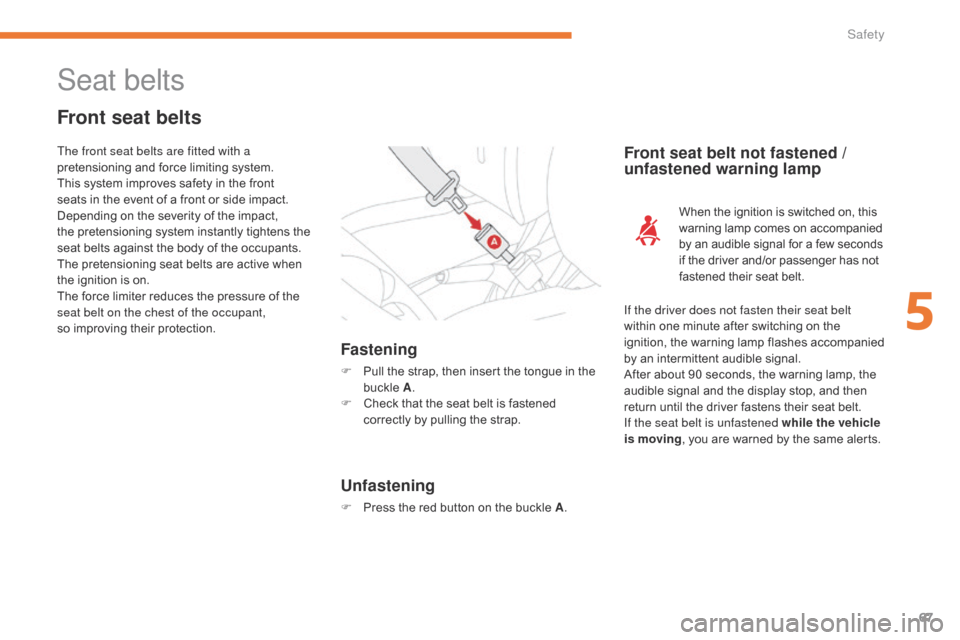
67
C-Zero_en_Chap05_securite_ed01-2016
Seat belts
Front seat belts
Fastening
F Pull the strap, then insert the tongue in the buckle A.
F
C
heck that the seat belt is fastened
correctly by pulling the strap.
Front seat belt not fastened /
unfastened warning lamp
If the driver does not fasten their seat belt
within one minute after switching on the
ignition, the warning lamp flashes accompanied
by an intermittent audible signal.
After about 90 seconds, the warning lamp, the
audible signal and the display stop, and then
return until the driver fastens their seat belt.
If the seat belt is unfastened while the vehicle
is moving , you are warned by the same alerts.
The front seat belts are fitted with a
pretensioning and force limiting system.
This system improves safety in the front
seats in the event of a front or side impact.
Depending on the severity of the impact,
the pretensioning system instantly tightens the
seat belts against the body of the occupants.
The pretensioning seat belts are active when
the ignition is on.
The force limiter reduces the pressure of the
seat belt on the chest of the occupant,
so improving their protection.
Unfastening
F Press the red button on the buckle A
.When the ignition is switched on, this
warning lamp comes on accompanied
by an audible signal for a few seconds
if the driver and/or passenger has not
fastened their seat belt.
5
Safety
Page 70 of 174

68
C-Zero_en_Chap05_securite_ed01-2016
Rear seat belts
Each rear seat is fitted with a three-point inertia
reel seat belt.
Fastening
F Pull the strap, then insert the tongue in the buckle.
F
C
heck that the seat belt is fastened
correctly by pulling the strap.
Unfastening
F Press the red button in the buckle.
Seat belt unfastened warning
lamps
Right-hand rear seat belt warning
lamp.
Left-hand rear seat belt warning
lamp.
Illumination of one of these warning lamps in
the instrument panel indicates that one of the
rear passengers has unbuckled their seat belt.
Safety